Unlike Sapphire's heavyweight RX Vega64 Nitro+, the Gigabyte RX Vega56 Gaming OC is more of a grey mouse with a fairly healthy body measure index. Just don't stand out at all costs. And it almost seems as if it was even deliberately designed to arouse as few desires as possible, so as not to trigger any demand (which one could never have satisfied anyway).
To spoil it in advance: this card also has its good sides and it will also show us what a normal "butter-and-bread card" with Vega10 could have looked like, or perhaps even should have looked like. It is thus the exact opposite of the Sapphire card and yet also has its own personal touch. Since it is likely to be even rarer than the big sister, gigabytes RX Vega56 Gaming OC is now starting.
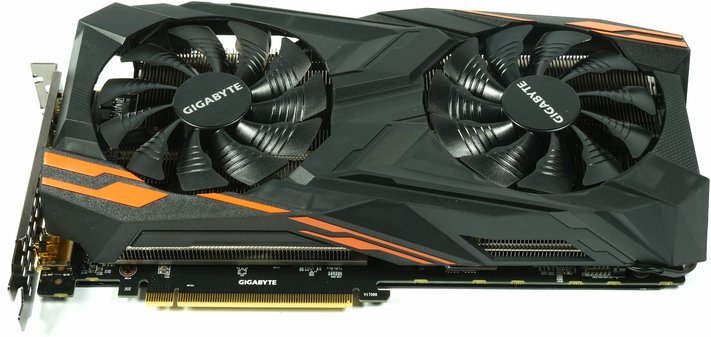
Market and availability
From internal sources, we know that the AIB received only a few chips in amD's mid-four-digit range, most of them Vega64. The general scarcity of packages thus prevents real mass production at the moment, because one cannot constantly drive and shut down a production line or even have it paused for longer. Costs and effort would simply be too high.
The fact that we were still able to get a copy is not due to the above-average capabilities of German importers, especially since, according to internal information, only cards in the double-digit range were available here, but on a certain Self-initiative in self-importing (including taxes).
Unboxing, optics and haptics
Weighing just over a kilogram, the Gigabyte card is an astonishing 600 grams lighter than Sapphire's monstrous battleship. Gigabyte has also saved more significantly in dimensions and offers a relatively short map with only 27.8 cm installation length (outer surface slot panel until the end of the radiator cover). With a height of 13 cm (from the top of the motherboard slot to the top of the radiator cover, as well as a thickness of 4.7 cm from the board to the front of the radiator cover, the picture is a rather compact map.
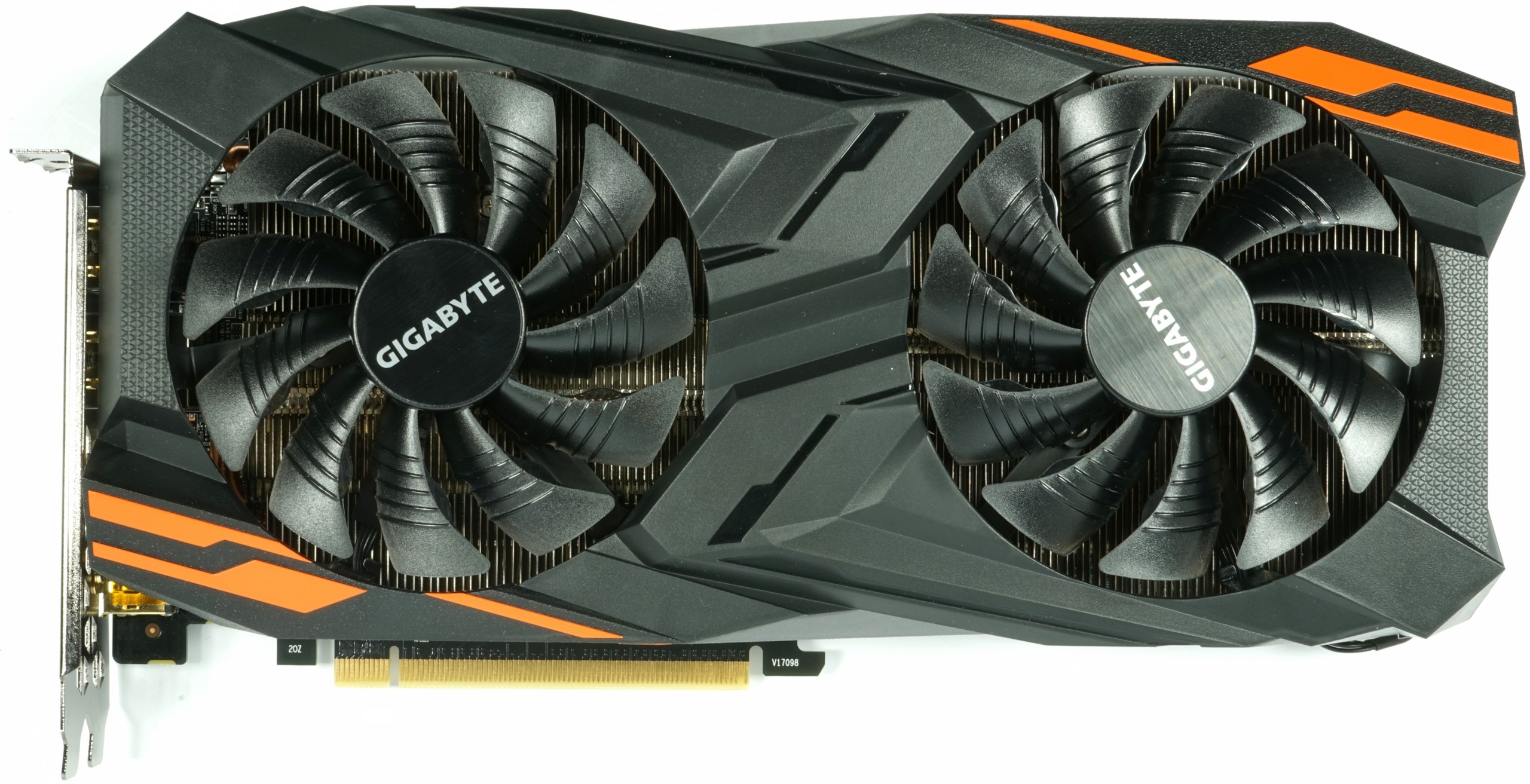
The two counter-rotating fans with a rotor blade diameter of 9.5 cm each sit in an opening with a diameter of 10 cm. A total of 11 rotor blades per fan, with their special shape, mainly provide airflow and turbulence and less static pressure. This should be helpful to the cooling concept.
The backplate dispenses with the Aorus logo, which still featured on the pre-production model. The copper insert, which sits above the back of the package, thermally separates the backplate used for cooling from this area and also cools – a little. The integrated heatpipe is not (yet) seen here on these pictures. More on that later.
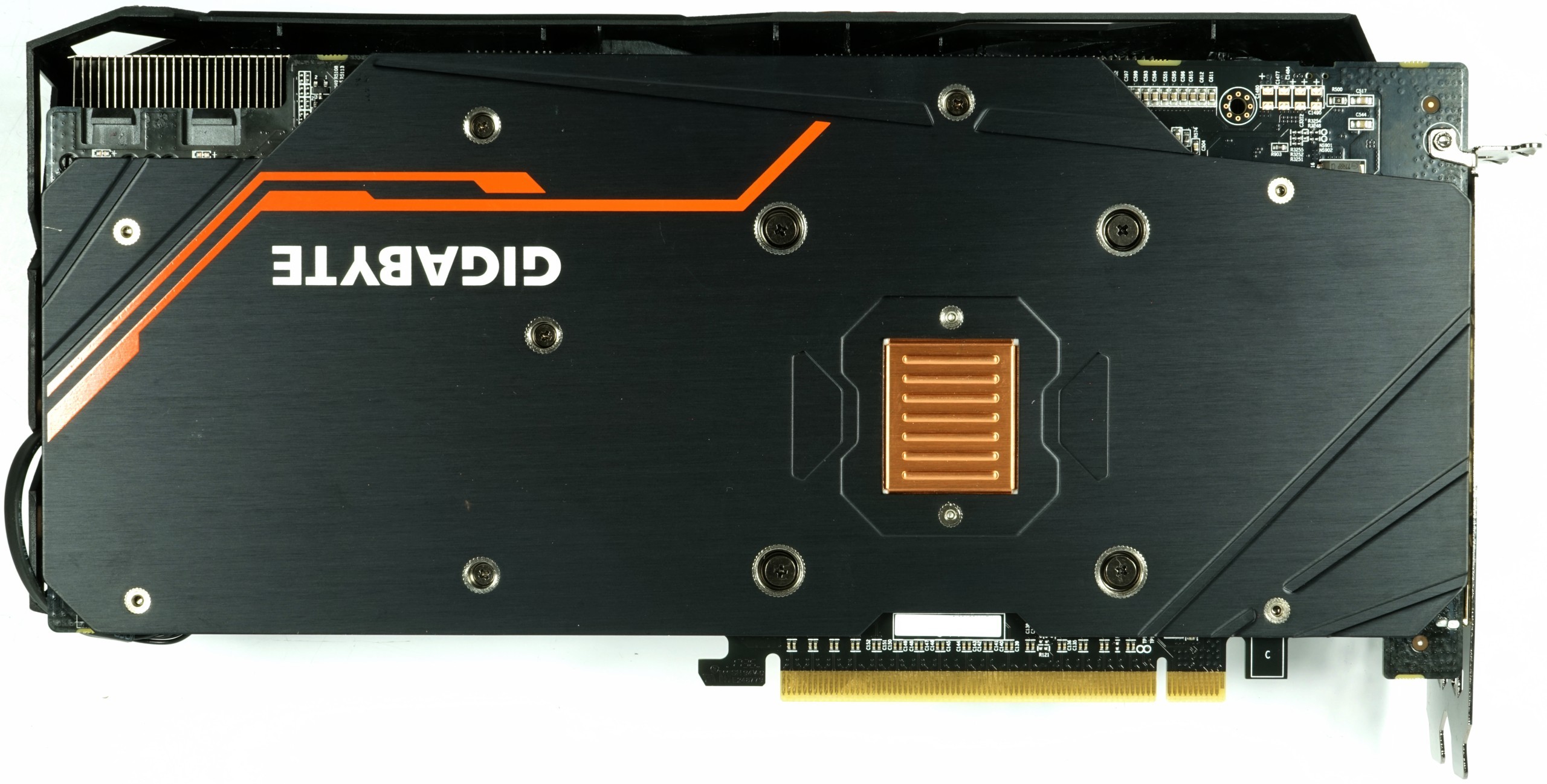
After all, one should plan at least 5 mm for the rear body, which can already lead to problems with some motherboards if heat sinks are sitting too close to the slot or the CPU cooler is extremely large.
It is already clear at the bottom of the card that Gigabyte has also worked a little on the shape of the vertically arranged slats. Due to the inclination and the waveform, the airflow should cool more efficiently. We will be questioning this at a later stage.

The top also clearly shows that Gigabyte has deliberately set the red pencil. No RGB effects and other LED playstuffs, but a somewhat jagged plastic desert of injection molding and printed orange color accents. The white gigabyte logo is also only printed. In addition, gigabytes of two 8-pin sockets are sufficient for external power supply.

The closed end of the card shows not much except the end of the two 8 mm and three 6 mm heatpipes, but only the connection cable of the fans. Other possible sockets were provided on the board (e.g. RGB output), which has been omitted in the course of development.
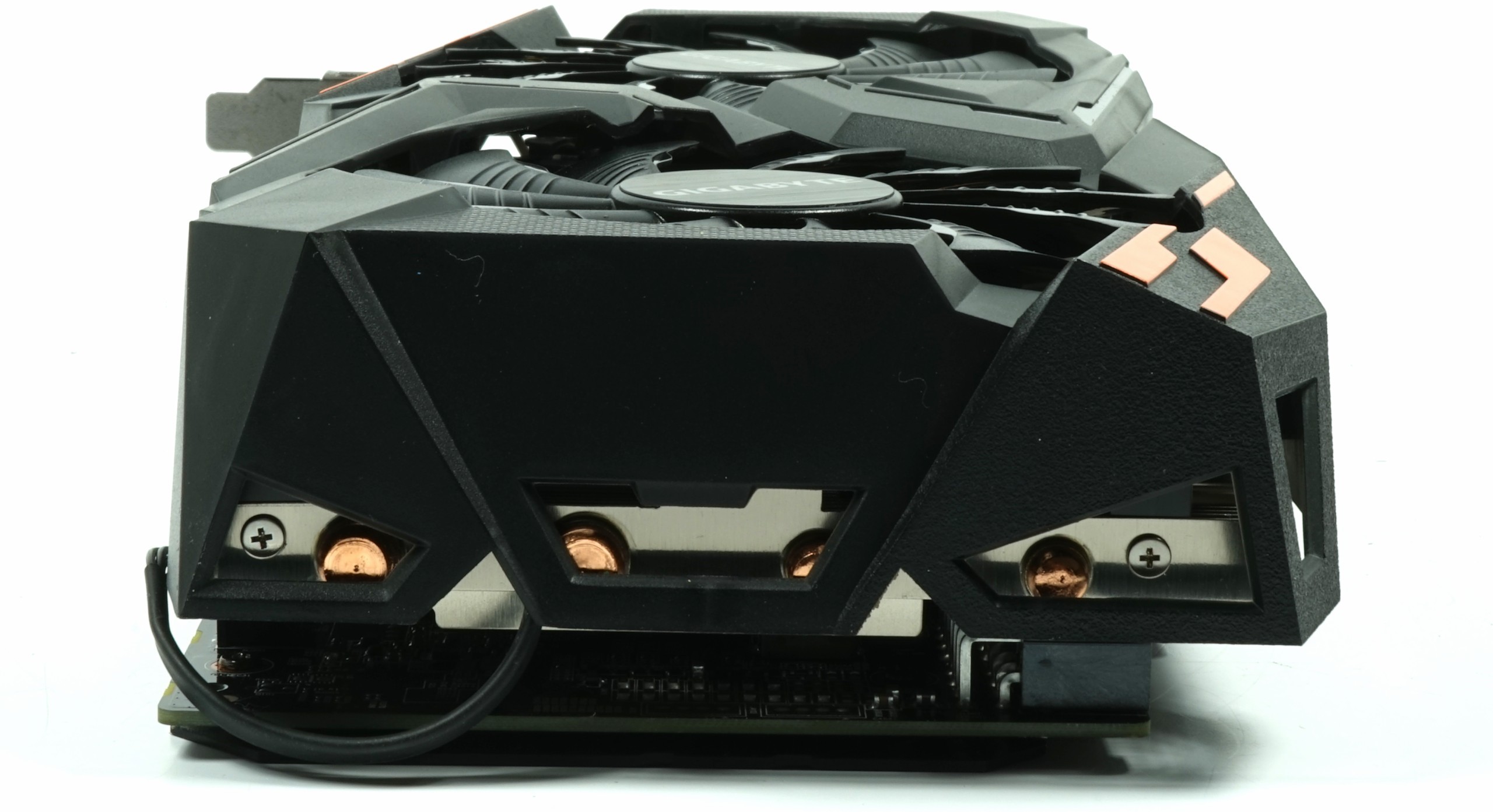
The slot panel is very interesting in that it has six instead of the five connectors of the reference card. Three HDMI 2.0 ports and three DisplayPorts 1.4 are available to the user. This makes the card suitable for connecting up to six monitors in eyefinity mode.
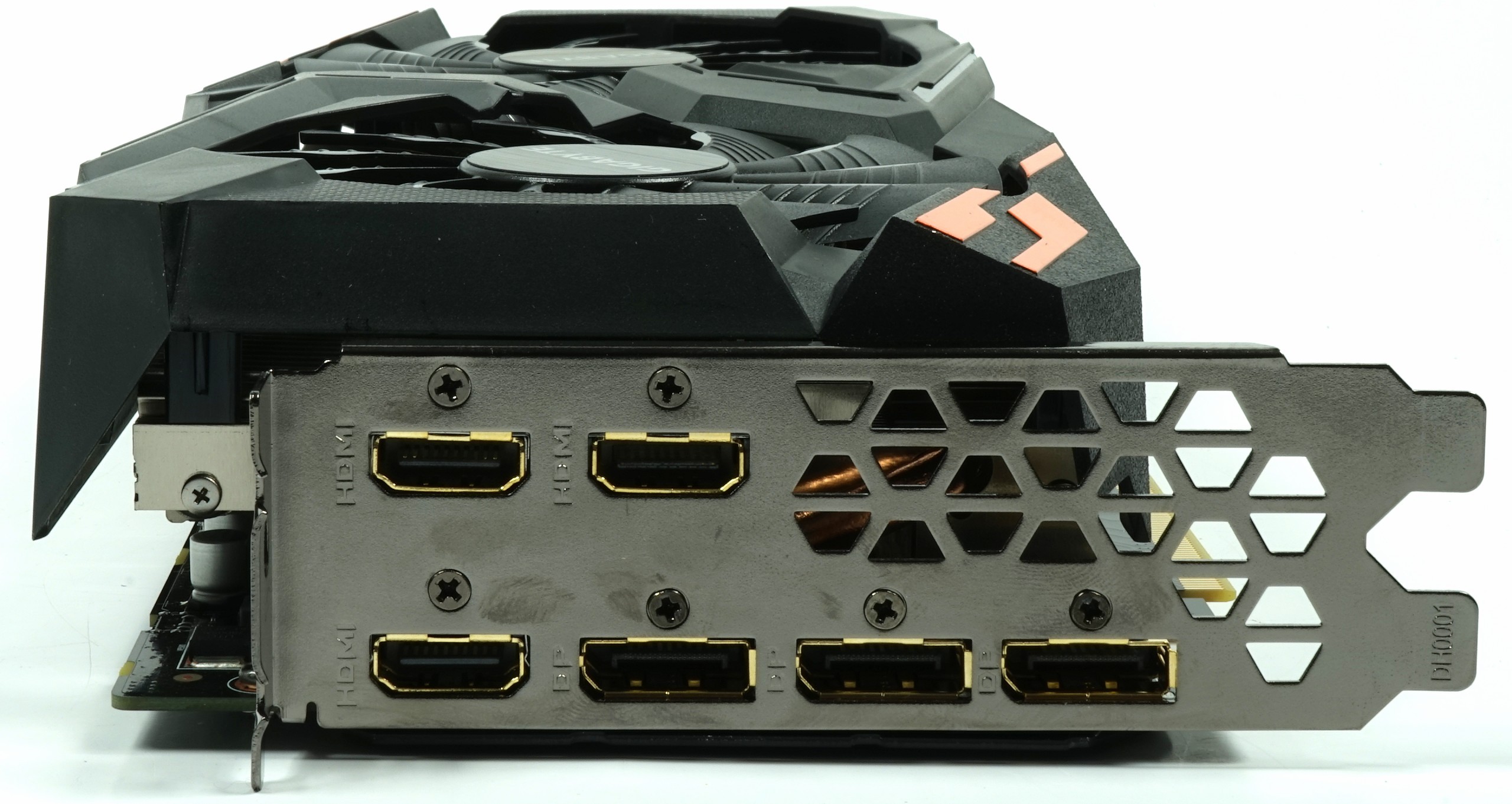
Finally, let us take a first look at the technical data. Gigabyte, following AMD's guidelines for clock frequencies, has both increased the maximum turbo clock by more than 100 MHz, as well as the power limit by 55 watts in conjunction with it. We will see what this really yields in reality.
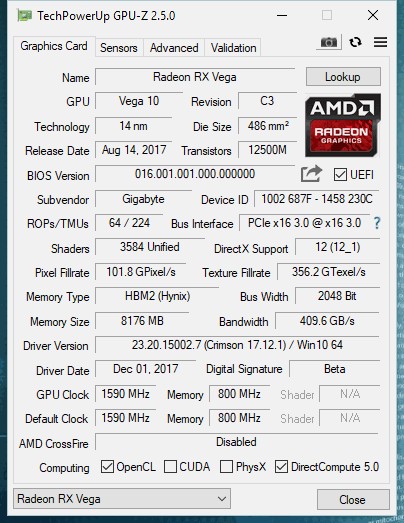
Compared to the relevant reference cards, this looks like this (we deliberately did not use the GeForce GTX 1070, as the overclocked RX Vega56 often acts much faster):
| Model | Radeon RX Vega64 Reference |
Gigabyte RX Vega56 Gaming OC |
Radeon RX Vega56 Reference |
Geforce GTX 1070 Ti |
Geforce GTX 1080 Fe |
|---|---|---|---|---|---|
| Gpu | Vega 10 | Vega 10 | Vega 10 | GP104 | GP104 |
| Chip size | 484 mm2 | 484 mm2 | 484 mm2 | 314 mm2 | 314 mm2 |
| Transistors | 12.5 billion | 12.5 billion | 12.5 billion | 7.2 billion | 7.2 billion |
| GPU base clock/ Boost clock |
1274 MHz 1546 MHz |
1275 MHz 1590 MHz |
1156 MHz 1471 MHz |
1607 MHz 1683 MHz |
1607 MHz 1733 MHz |
| Shader/SIMD | 4096/64 | 3585/56 | 3585/56 | 2432/19 | 2560/20 |
| Texture Units/ Rops |
256 64 |
224 64 |
224 64 |
152 64 |
160 64 |
| Pixel fill rate |
99 GPix/s | 102 GPix/s | 94 GPix/s | 108 GPix/s | 114 GPix/s |
| Texture Fill Rate | 396 GTex/s | 356 GTex/s | 330 GTex/s | 244 GTex/s | 257 GTex/s |
| Memory connection | 2048 Bit | 2048 Bit | 2048 Bit | 256 bits | 256 bits |
| Storage type | HBM2 | HBM2 | HBM2 | GDDR5 | GDDR5X |
| Memory bandwidth |
484 GB/s | 410 GB/s | 410 GB/s | 256 GB/s | 320 GB/s |
| Memory clock |
1.9 Gbps | 1.6 Gbps | 1.6 Gbps | 8 Gbps | 10 Gbps |
| Storage expansion |
8 GB | 8 GB | 8 GB | 8 GB | 8 GB |
| DX Feature Level | 12_1 | 12_1 | 12_1 | 12_1 | 12_1 |
| PCIe sockets | 2 x 8-pin | 2x 8 Pin | 2 x 8-pin | 1x 8-pin | 1x 8-pin |
| Tbp | 295 watts | 265 watts | 210 watts | 180 watts | 180 watts |
Test system and measurement methods
The new test system and the methodology have already been described in great detail in the basic article "How We Test Graphics Cards" (English: "How We Test Graphics Cards") and therefore, for the sake of simplicity, we now only refer to this detailed Description. So if you want to read everything again, you are welcome to do so. However, we have again improved CPU and cooling to largely exclude possible CPU bottlenecks for this fast card.
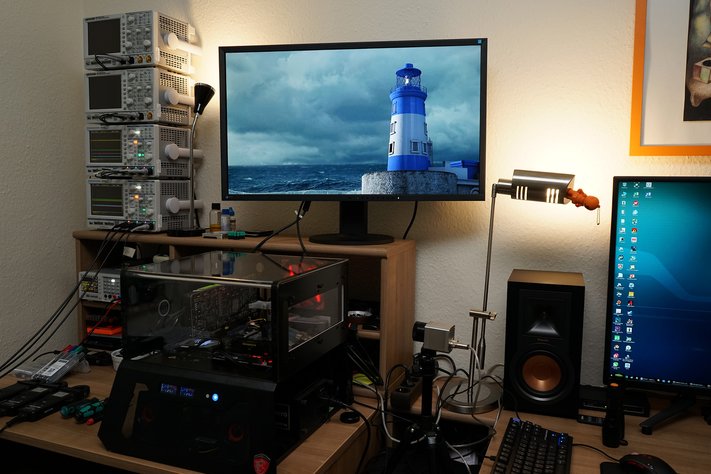
If you are interested, the summary in table form quickly provides a brief overview:
| Test systems and measuring rooms | |
|---|---|
| Hardware: |
Intel Core i7-6900K -4.3GHz MSI X99S XPower Gaming Titanium G.Skill TridentZ DDR4 3600 1x 1 TByte Toshiba OCZ RD400 (M.2, System SSD) 2x 960 GByte Toshiba OCZ TR150 (Storage, Images) Be Quiet Dark Power Pro 11, 850-watt power supply |
| Cooling: |
Alphacool Ice Block XPX 5x Be Quiet! Silent Wings 3 PWM (Closed Case Simulation) Thermal Grizzly Kryonaut (for cooler change) |
| Housing: |
Lian Li PC-T70 with expansion kit and modifications Modes: Open Benchtable, Closed Case |
| Monitor: | Eizo EV3237-BK |
| Power consumption: |
non-contact DC measurement on the PCIe slot (Riser-Card) non-contact DC measurement on the external PCIe power supply Direct voltage measurement on the respective feeders and on the power supply 2x Rohde & Schwarz HMO 3054, 500 MHz multi-channel oscillograph with memory function 4x Rohde & Schwarz HZO50, current togor adapter (1 mA to 30 A, 100 KHz, DC) 4x Rohde & Schwarz HZ355, touch divider (10:1, 500 MHz) 1x Rohde & Schwarz HMC 8012, digital multimeter with storage function |
| Thermography: |
Optris PI640, infrared camera PI Connect evaluation software with profiles |
| Acoustics: |
NTI Audio M2211 (with calibration file) Steinberg UR12 (with phantom power for the microphones) Creative X7, Smaart v.7 own low-reflection measuring room, 3.5 x 1.8 x 2.2 m (LxTxH) Axial measurements, perpendicular to the center of the sound source(s), measuring distance 50 cm Noise in dBA (Slow) as RTA measurement Frequency spectrum as a graph |
| Operating system | Windows 10 Pro (Creators Update, all updates) Radeon Software Adrenaline (17.12.2, status December 2017) |































Kommentieren